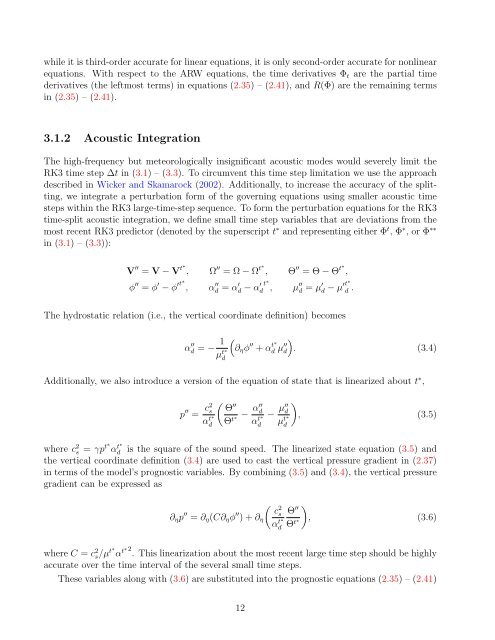Advanced Research WRF (ARW) Technical Note - MMM - University ...
Advanced Research WRF (ARW) Technical Note - MMM - University ...
Advanced Research WRF (ARW) Technical Note - MMM - University ...
You also want an ePaper? Increase the reach of your titles
YUMPU automatically turns print PDFs into web optimized ePapers that Google loves.
while it is third-order accurate for linear equations, it is only second-order accurate for nonlinear<br />
equations. With respect to the <strong>ARW</strong> equations, the time derivatives Φt are the partial time<br />
derivatives (the leftmost terms) in equations (2.35) – (2.41), and R(Φ) are the remaining terms<br />
in (2.35) – (2.41).<br />
3.1.2 Acoustic Integration<br />
The high-frequency but meteorologically insignificant acoustic modes would severely limit the<br />
RK3 time step ∆t in (3.1) – (3.3). To circumvent this time step limitation we use the approach<br />
described in Wicker and Skamarock (2002). Additionally, to increase the accuracy of the splitting,<br />
we integrate a perturbation form of the governing equations using smaller acoustic time<br />
steps within the RK3 large-time-step sequence. To form the perturbation equations for the RK3<br />
time-split acoustic integration, we define small time step variables that are deviations from the<br />
most recent RK3 predictor (denoted by the superscript t ∗ and representing either Φ t , Φ ∗ , or Φ ∗∗<br />
in (3.1) – (3.3)):<br />
V ′′ = V − V t∗<br />
, Ω ′′ = Ω − Ω t∗<br />
, Θ ′′ = Θ − Θ t∗<br />
,<br />
φ ′′ = φ ′ ∗<br />
′t<br />
− φ , α ′′<br />
d = α ′ d − α ′ t<br />
d<br />
∗<br />
, µ ′′<br />
d = µ ′ ∗<br />
′t<br />
d − µ d .<br />
The hydrostatic relation (i.e., the vertical coordinate definition) becomes<br />
α ′′<br />
d = − 1<br />
µ t∗<br />
<br />
∂ηφ<br />
d<br />
′′ + α t∗<br />
d µ ′′<br />
<br />
d . (3.4)<br />
Additionally, we also introduce a version of the equation of state that is linearized about t ∗ ,<br />
p ′′ = c2s αt∗ ′′ Θ<br />
d Θt∗ − α′′ d<br />
αt∗ d<br />
− µ′′ d<br />
µ t∗<br />
<br />
, (3.5)<br />
d<br />
where c2 s = γpt∗αt∗ d is the square of the sound speed. The linearized state equation (3.5) and<br />
the vertical coordinate definition (3.4) are used to cast the vertical pressure gradient in (2.37)<br />
in terms of the model’s prognostic variables. By combining (3.5) and (3.4), the vertical pressure<br />
gradient can be expressed as<br />
∂ηp ′′ = ∂η(C∂ηφ ′′ ) + ∂η<br />
2 cs αt∗ Θ<br />
d<br />
′′<br />
Θt∗ <br />
, (3.6)<br />
where C = c2 s/µ t∗αt∗2<br />
. This linearization about the most recent large time step should be highly<br />
accurate over the time interval of the several small time steps.<br />
These variables along with (3.6) are substituted into the prognostic equations (2.35) – (2.41)<br />
12
















